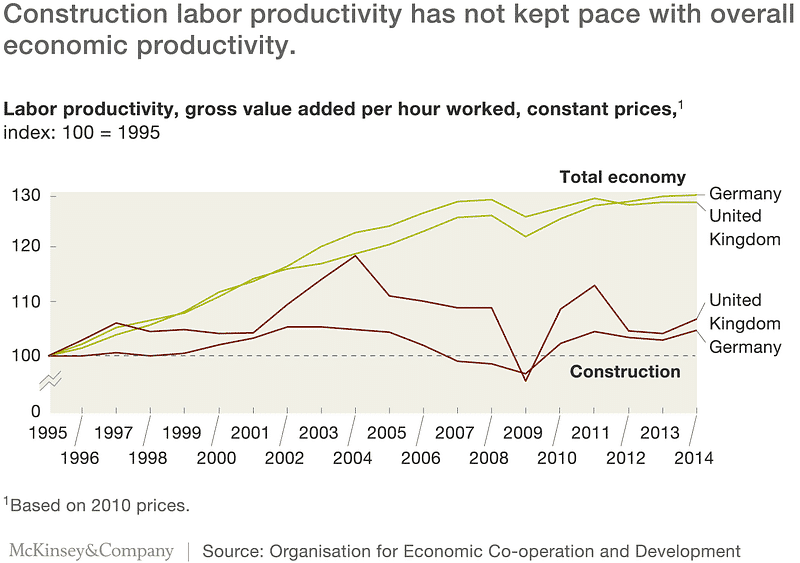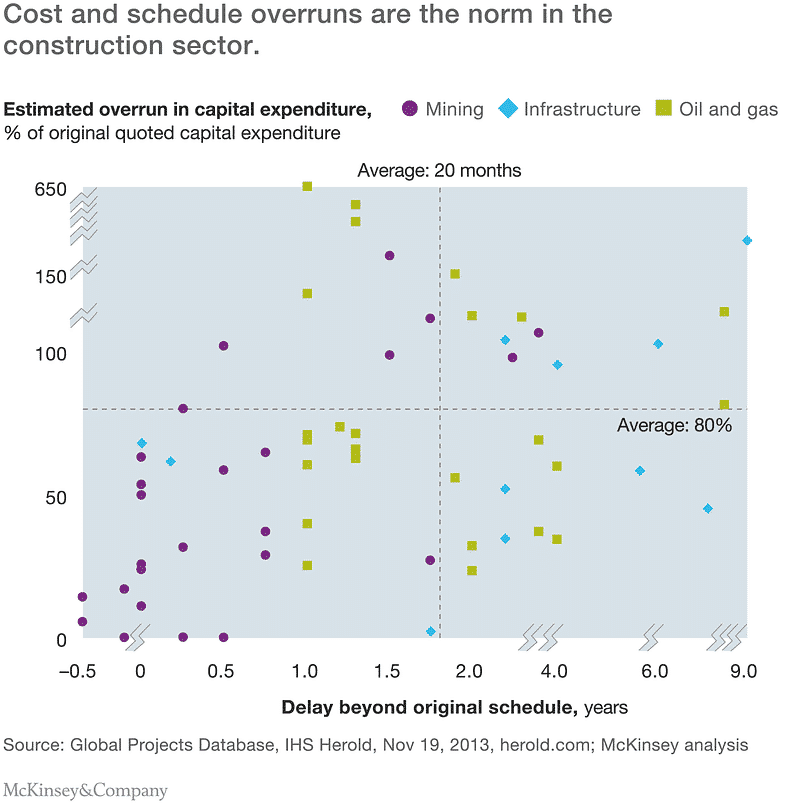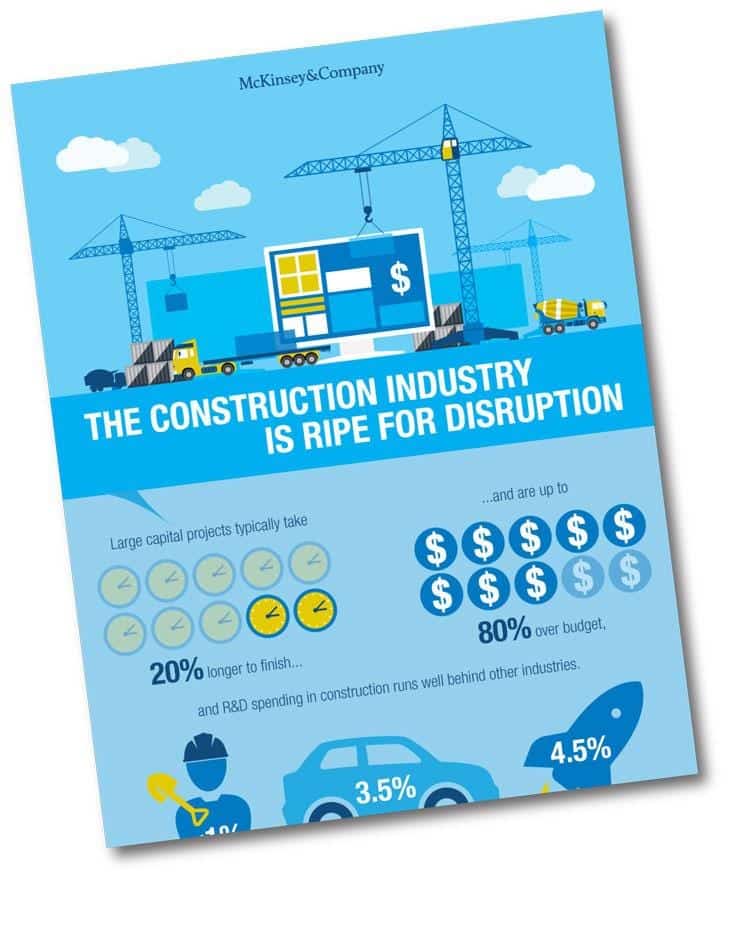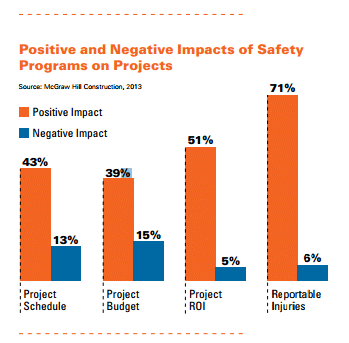The slow transition to a digital practice has the construction industry underperforming in terms of quality and productivity versus investment growth. As investment in infrastructure is growing fast (predicted to double by the next 15 years), it is surprising to note that the methods and processes employed are still traditional. Work is still performed manually and on-site and mostly outdated with productivity dwindling down since the 90s.
According to a study conducted by the McKinsey Global Institute, global investment in construction and infrastructure will be $57 trillion by 2030 (McKinsey, 2013). The sector, however, barely spends on research and development (just about 1% of its revenues). Software solutions have been developed specifically for the industry but less than 1% of the sector’s revenues were spent on them.

Delays and Overspendings
Traditional construction practices can be costly and inefficient. In fact, with large projects, the industry fails to deliver on time, within budget and to specifications. In a separate study, it was reported that 98% of these projects had cost overruns of more than 30% and 77% were at least 40% late (McKinsey, 2015). Large projects take at least 20% longer to finish and are up to 80% over the budget (McKinsey, 2016). The industry’s unhurried need to adapt to new technology has been steadily declining financial returns for contractors.

An important point to note is that even though construction is inherently long-term, the industry does not think long term. This mindset leads to poor productivity and cost outcomes, which are serious and systemic construction issues that are seen as “normal”. Labor productivity can no longer keep up with the overall economic productivity.

A few important factors of these construction problems have been identified and they are the following:
- Bad Organizational Structure
The construction project management practice’s decision making and procurement processes do not have the capacity for the current speed and scale demand. - Deficient Communication
The lack of a central data system results to delayed and inconsistent sharing of information and reports. This leads to subcontractors, contractors, and owners not having a common understanding of the project’s state at any given time.
Click here to discover how we can help you to improve your internal communication. - Weak Performance Management
Midstream changes, inadequate communication and lack of accountability lead to unresolved issues piling up. - Non-Universality of Information
When a different team carries over work to a different team for the next process and when a problem comes up arising from the previous process, the construction project manager may have a hard time understanding how to proceed. For example, the procurement team deals with complicated contracts and when a problem with the contracts arise while in the middle of construction, it may confuse the CPM (construction project management) lead. - Connection Gaps
Planning spans a lot of aspects; it includes high-end preparation and daily tasks. If daily work does not align with the day’s goal, schedulers should be notified but often are not. This system ends in delays due to the absence of real-time updating of task priorities. - Poor Short-Term Calculations
Another construction issue is that companies are good at planning and forecasting outcomes in the next 3 months but fail to identify and calculate work in the next week or two. This often results in delays that may be caused by unavailability of an equipment or materials. - Inadequate Risk Management
Construction managers and contractors are usually looking into long-term risks of planning, design, construction, operations, and maintenance. Risks that just pop up on the job are usually overlooked. These tiny construction issues may just have a snowball delay in decision making and compound to major schedule overruns. - Limited Skill Capabilities
Another cultural problem in construction is that companies tend to work with previous people and teams and fail to connect with more capable firms and manpower suited for the job.
Safety Issues
Another aspect to look at is safety management practices. Work injuries can set project schedule back by one week or even more and may cause budget overspending to compensate for its outcomes. Investing in strong safety management programs ultimately reduce injury rates thereby decreasing schedule and budget overruns and ultimately improving project ROI and company reputation.
The integration of technology in the industry like documenting safety concerns, using building information modeling (BIM), and prefabrication and modularization are impacting positive safety outcomes for companies that embrace them (McGraw Hill Construction, 2013).

The Bigger Picture
Improving on “basic” project management skills is the most potent remedy for reducing construction problems and improving construction performance (McKinsey, 2015). Embracing transparency and real-time collaboration create a continuous work flow — a transparent environment makes it easier to resolve issues faster. Efficient and effective tracking aligned with preparedness for unseen events enable the construction team to anticipate micro-changes and allow them to adapt and adjust accordingly.
With transparency, real-time data, and tracking, a change-order process is created and minimizes time delays in disputes during construction. The result would be reduced idle time and a most promising solution to improving construction site productivity.
The integration of technology in the industry practice definitely plays a huge role in improving construction productivity. But do not forget that it is only a tool. Using it strategically to improve project management is the bigger challenge. An improvement in performance and productivity equal to an improvement in financial returns but there is a bigger picture here.
Creating a trend towards a healthy and productive construction industry will benefit the whole world.
An updated opinion piece regarding the construction industry’s slow delivery practice discusses how embracing new ideas could solve construction’s poor delivery practice.




